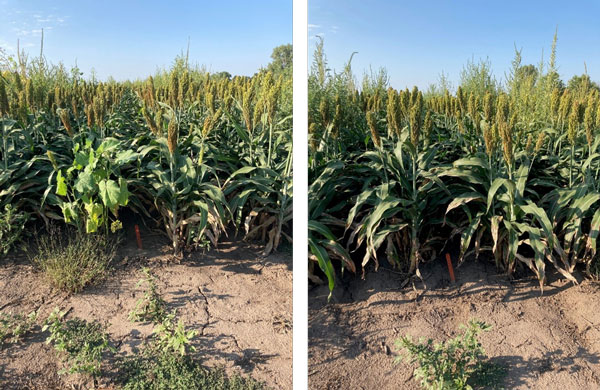As of late December, grain sorghum farmers have access to IMIFLEX™ herbicide to use in igrowth® grain sorghum for the 2021 growing season. IMIFLEX is sold by UPL® NA, Inc. and igrowth sorghum is sold by Alta® Seeds. igrowth grain sorghum is resistant to imazamox. Some may be familiar with imazamox as the active ingredient in Beyond, Raptor, and other herbicides. However, IMIFLEX is the only formulation of imazamox that will be labeled for use in igrowth grain sorghum. IMIFLEX is also labeled for use in alfalfa, dry beans and peas, and soybean; however, it will not be marketed for other labelled crops this year.
What are the target weeds for this herbicide?
IMIFLEX will be helpful for growers needing to control troublesome grasses such as large crabgrass and foxtail species when applied pre-emergence or early post-emergence to plants up to 3 inches tall. Interestingly, johnsongrass, and shattercane are not listed as controlled species. This is an important component of product stewardship, which will be discussed in more detail later in this document. Broadleaf weeds controlled by IMIFLEX include morningglories, velvetleaf and seedling bindweeds, as well as populations of pigweeds and kochia that are not ALS-resistant.
Herbicides use rates and rotation intervals
Use rates for IMIFLEX are 6 to 9 fl oz per acre pre-emergence or 6 fl oz per acre post-emergence. Post-emergence applications should occur before grain sorghum is 20 inches tall and target small, actively growing weeds. Applications of IMIFLEX must include an adjuvant (COC, MSO, HSOC, or NIS) and a nitrogen fertilizer (AMS or UAN). If tank mixing with dicamba or 2,4-D, NIS should be used instead of an oil-based surfactant to avoid crop injury. In addition, IMIFLEX should not be tank mixed with the herbicides metsulfuron-methyl, prosulfuron, or bromoxynil + pyrasulfotole or with organophosphate or carbamate insecticides (such as malathion or carbaryl).
There are also some crop rotation intervals that impact crops grown in Kansas, including: 3 months to non-Clearfield wheat, 8 1/2 months to non-Clearfield corn, 9 months to cotton and sunflower, 18 months to non-igrowth grain sorghum, and 18 to 26 months to non-Clearfield canola.

Figure 1. On left, igrowth sorghum plots at Manhattan, KS treated with IMFLEX and atrazine pre-emergence followed by 2,4-D post-emergence. On right, mesotrione plus S-metolachlor pre-emergence followed by IMIFLEX applied post-emergence. Photos by Sarah Lancaster, K-State Research and Extension.
Practice good stewardship
As mentioned earlier in the article, stewardship of IMIFLEX is very important – especially in terms of herbicide resistant weeds. Imazamox is Group 2 (ALS-inhibiting) herbicide in the imidazolinone (“imi”) family. Kochia, Palmer amaranth, waterhemp, common sunflower, and shattercane are among the weed species in Kansas that already have documented resistance to Group 2 herbicides. Mixing and rotating herbicides is one of the key practices that should be used to slow the development of herbicide resistance. In fact, IMIFLEX may only be applied one time per year and igrowth sorghum should not be planted in the same field two years in a row. Also, igrowth grain sorghum should not be planted in fields where ALS-resistant shattercane or johnsongrass exist.
Sarah Lancaster, Extension Weed Science Specialist
slancaster@ksu.edu
Tags: grain sorghum weed control herbicide resistance IMIFLEX